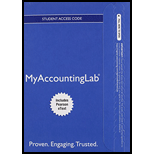
Calculating conversion costs and unit cost
Russia Spring produces premium bottled water. Russia Spring purchases artesian water, stores the water in large tanks, and then runs the water through two processes: filtration and bottling.
During February, the filtration process incurred the following
Wages of workers operating filtration equipment $ 19,950
Manufacturing
150,000
Russia Spring had no beginning Work-in-Process Inventory in the Filtration Department in February.
Requirements
1. Compute the February conversion costs in the Filtration Department.
2. The Filtration Department completely processed 150.000 liters in February. What was the filtration cost per liter?
Note- Short Exercise S20-5 must be completed before attempting Short Exercise S20-6.
S20-6 Computing EUP
Refer to Short Exercise S20-5. At Russia Spring, water is added at the beginning of the filtration process. Conversion costs are added evenly throughout the process. Now assume that in February, 80,000 liters were completed and transferred out of the Filtration Department into the Bottling Department. The 70,000 liters remaining in Filtration’s ending Work-in-Process Inventory were 80% of the way through the filtration process. Recall that Russia Spri9ng has no beginning inventories.
Compute the equivalent units of production for direct materials and conversion costs for the Filtration Department.
Want to see the full answer?
Check out a sample textbook solution
Chapter 20 Solutions
MyLab Accounting with Pearson eText -- Access Card -- for Horngren's Accounting, The Financial Chapters (My Accounting Lab)
- QS 15-18 (Algo) Computing and recording over- or underapplied overhead LO P4 A company applies overhead at a rate of 170% of direct labor cost. Actual overhead cost for the current period is $1,081,900, and direct labor cost is $627,000. 1. Compute the under- or overapplied overhead. 2. Prepare the journal entry to close over- or underapplied overhead to Cost of Goods Sold. Complete this question by entering your answers in the tabs below. Required 1 Required 2 Compute the under- or overapplied overhead.arrow_forwardQuestion 6 During 2019, Bitsincoins Corporation had EBIT of $100,000, a change in net fixed assets of $400,000, an increase in net current assets of $100,000, an increase in spontaneous current liabilities of $400,000, a depreciation expense of $50,000, and a tax rate of 30%. Based on this information, what is Bitsincoin's free cash flow? (3 marks)arrow_forwardQuestion 4 Waterfront Inc. wishes to borrow on a short-term basis without reducing its current ratio below 1.25. At present its current assets and current liabilities are $1,600 and $1,000 respectively. How much can Waterfront Inc. borrow? (5 marks)arrow_forward
 Managerial AccountingAccountingISBN:9781337912020Author:Carl Warren, Ph.d. Cma William B. TaylerPublisher:South-Western College Pub
Managerial AccountingAccountingISBN:9781337912020Author:Carl Warren, Ph.d. Cma William B. TaylerPublisher:South-Western College Pub Principles of Cost AccountingAccountingISBN:9781305087408Author:Edward J. Vanderbeck, Maria R. MitchellPublisher:Cengage Learning
Principles of Cost AccountingAccountingISBN:9781305087408Author:Edward J. Vanderbeck, Maria R. MitchellPublisher:Cengage Learning

